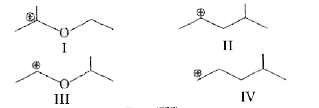The correct bond order among the following species is :
N2−2>N−2>N2>N+2
N2>N−2=N+2>N2−2
N2−2>N+2>N−2>N2
N−2>N2=N2−2>N+2
The correct Answer is:B
To determine the correct bond order among the species N2, N2+, N2-, N2 2+, and N2 2-, we will calculate the bond order for each species step by step.
Step 1: Calculate Bond Order for N2
1. Determine the total number of electrons:
- Each nitrogen atom has 7 electrons. For N2, the total number of electrons = 7 x 2 = 14 electrons.
2. Write the molecular electronic configuration:
- The configuration for N2 is:
- σ1s² σ*1s² σ2s² σ*2s² π2px² π2py² σ2pz² π*2px⁰ π*2py⁰ σ*2pz⁰
3. Count the electrons in bonding and antibonding orbitals:
- Bonding orbitals: σ1s (2) + σ2s (2) + π2px (2) + π2py (2) + σ2pz (2) = 10 electrons.
- Antibonding orbitals: σ*1s (2) + σ*2s (2) = 4 electrons.
4. Calculate bond order:
- Bond order = 1/2 (Number of bonding electrons - Number of antibonding electrons)
- Bond order = 1/2 (10 - 4) = 3.
Step 2: Calculate Bond Order for N2+
1. Determine the total number of electrons:
- N2+ has one less electron, so total electrons = 14 - 1 = 13 electrons.
2. Write the molecular electronic configuration:
- The configuration for N2+ is:
- σ1s² σ*1s² σ2s² σ*2s² π2px² π2py² σ2pz¹ π*2px⁰ π*2py⁰
3. Count the electrons in bonding and antibonding orbitals:
- Bonding orbitals: 9 electrons (same as N2, but one less in σ2pz).
- Antibonding orbitals: 4 electrons.
4. Calculate bond order:
- Bond order = 1/2 (9 - 4) = 2.5.
Step 3: Calculate Bond Order for N2-
1. Determine the total number of electrons:
- N2- has one extra electron, so total electrons = 14 + 1 = 15 electrons.
2. Write the molecular electronic configuration:
- The configuration for N2- is:
- σ1s² σ*1s² σ2s² σ*2s² π2px² π2py² σ2pz² π*2px¹ π*2py⁰
3. Count the electrons in bonding and antibonding orbitals:
- Bonding orbitals: 10 electrons (same as N2).
- Antibonding orbitals: 5 electrons.
4. Calculate bond order:
- Bond order = 1/2 (10 - 5) = 2.5.
Step 4: Calculate Bond Order for N2 2+
1. Determine the total number of electrons:
- N2 2+ has two less electrons, so total electrons = 14 - 2 = 12 electrons.
2. Write the molecular electronic configuration:
- The configuration for N2 2+ is:
- σ1s² σ*1s² σ2s² σ*2s² π2px² π2py² σ2pz²
3. Count the electrons in bonding and antibonding orbitals:
- Bonding orbitals: 8 electrons.
- Antibonding orbitals: 4 electrons.
4. Calculate bond order:
- Bond order = 1/2 (8 - 4) = 2.
Step 5: Calculate Bond Order for N2 2-
1. Determine the total number of electrons:
- N2 2- has two extra electrons, so total electrons = 14 + 2 = 16 electrons.
2. Write the molecular electronic configuration:
- The configuration for N2 2- is:
- σ1s² σ*1s² σ2s² σ*2s² π2px² π2py² σ2pz² π*2px¹ π*2py¹
3. Count the electrons in bonding and antibonding orbitals:
- Bonding orbitals: 10 electrons.
- Antibonding orbitals: 6 electrons.
4. Calculate bond order:
- Bond order = 1/2 (10 - 6) = 2.
Summary of Bond Orders
- N2: Bond order = 3
- N2+: Bond order = 2.5
- N2-: Bond order = 2.5
- N2 2+: Bond order = 2
- N2 2-: Bond order = 2
Final Bond Order Comparison
The bond order from highest to lowest is:
1. N2 (3)
2. N2+, N2- (2.5)
3. N2 2+, N2 2- (2)
Conclusion
The correct order of bond order among the species is:
N2 > N2+, N2- > N2 2+, N2 2-.
1. Determine the total number of electrons:
- Each nitrogen atom has 7 electrons. For N2, the total number of electrons = 7 x 2 = 14 electrons.
2. Write the molecular electronic configuration:
- The configuration for N2 is:
- σ1s² σ*1s² σ2s² σ*2s² π2px² π2py² σ2pz² π*2px⁰ π*2py⁰ σ*2pz⁰
- Bonding orbitals: σ1s (2) + σ2s (2) + π2px (2) + π2py (2) + σ2pz (2) = 10 electrons.
- Antibonding orbitals: σ*1s (2) + σ*2s (2) = 4 electrons.
- Bond order = 1/2 (Number of bonding electrons - Number of antibonding electrons)
- Bond order = 1/2 (10 - 4) = 3.
1. Determine the total number of electrons:
- N2+ has one less electron, so total electrons = 14 - 1 = 13 electrons.
- The configuration for N2+ is:
- σ1s² σ*1s² σ2s² σ*2s² π2px² π2py² σ2pz¹ π*2px⁰ π*2py⁰
- Bonding orbitals: 9 electrons (same as N2, but one less in σ2pz).
- Antibonding orbitals: 4 electrons.
- Bond order = 1/2 (9 - 4) = 2.5.
1. Determine the total number of electrons:
- N2- has one extra electron, so total electrons = 14 + 1 = 15 electrons.
- The configuration for N2- is:
- σ1s² σ*1s² σ2s² σ*2s² π2px² π2py² σ2pz² π*2px¹ π*2py⁰
- Bonding orbitals: 10 electrons (same as N2).
- Antibonding orbitals: 5 electrons.
- Bond order = 1/2 (10 - 5) = 2.5.
1. Determine the total number of electrons:
- N2 2+ has two less electrons, so total electrons = 14 - 2 = 12 electrons.
- The configuration for N2 2+ is:
- σ1s² σ*1s² σ2s² σ*2s² π2px² π2py² σ2pz²
- Bonding orbitals: 8 electrons.
- Antibonding orbitals: 4 electrons.
- Bond order = 1/2 (8 - 4) = 2.
1. Determine the total number of electrons:
- N2 2- has two extra electrons, so total electrons = 14 + 2 = 16 electrons.
- The configuration for N2 2- is:
- σ1s² σ*1s² σ2s² σ*2s² π2px² π2py² σ2pz² π*2px¹ π*2py¹
- Bonding orbitals: 10 electrons.
- Antibonding orbitals: 6 electrons.
- Bond order = 1/2 (10 - 6) = 2.
- N2: Bond order = 3
- N2+: Bond order = 2.5
- N2-: Bond order = 2.5
- N2 2+: Bond order = 2
- N2 2-: Bond order = 2
The bond order from highest to lowest is:
1. N2 (3)
2. N2+, N2- (2.5)
3. N2 2+, N2 2- (2)
The correct order of bond order among the species is:
N2 > N2+, N2- > N2 2+, N2 2-.
Similar Questions
Knowledge Check
The correct bond order in the following species is:
AO+2<O−2<O2+2BO−2<O+2<O2+2CO2+2<O+2<O2−2DO2+2<O−2<O2+2The correct bond order in the following species is
AO+2<O−2<O2+2BO−2<O+2<O2+2CO2+2<O+2<O−2DO2+2<O−2<O+2The corrent bond order in the following species is
AO2+2<O−2<O+2BO+2<O−2<O2+2CO−2<O+2<O2+2DO2+2<O+2<O−2
The correct stability order of the following species is

View SolutionThe correct stability order for the following species is

View SolutionThe correct stability order for the following species is

View SolutionThe correct stability order for the following species is

View SolutionThe correct stability order for the following species is :

View Solution

